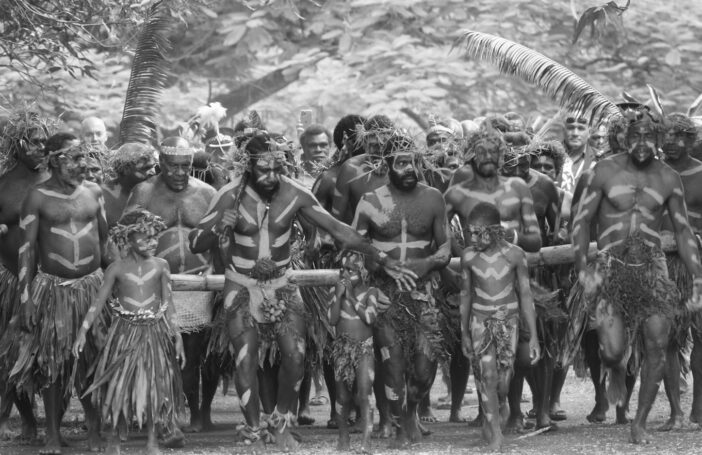“Climate displacement of populations is the main feature of our future. We have to be ready for it and plan for it now.” So said Vanuatu’s Minister for Climate Change, Ralph Regenvanu, when he took office in 2022.
The reality of any relocation in Vanuatu is that it is mostly carried out in the context of kastom (community-based culture), as 97% of land in Vanuatu is under customary tenure. The state’s role in managing disaster-induced displacement is nuanced owing to its overlap with customary institutions serving a similar function. Cultural systems must therefore be effectively integrated if disaster risk management is to be successful.
In Vanuatu, one of the nations most vulnerable to natural disasters, displacement is increasing as tropical cyclones get stronger and extreme rainfall events become more common. Volcanic eruptions also cause displacement. For example, owing to the eruptions of the Manaro volcano between 2017 and 2019, the entire population of Ambae island was evacuated twice. On Ambrym and Tanna islands, volcanic ashfalls have forced communities to migrate to commercial centres or neighbouring islands.
Communities’ responses to natural hazards were developed over generations and are woven into cultural knowledge and practices. However, this traditional environmental knowledge is now under duress owing to the increasing severity and frequency of weather events. The chief executive officer of the Malvatumauri National Council of Chiefs (MNCC), Chief Jean-Pierre Tom, notes:
There is an urgency to document traditional knowledge as it relates to disaster risk management. This also extends to issues of traditional architecture, food preservation techniques, inter-community food sharing, temporary relocation sites based on family networks, and anything that enhances community resilience in times of disaster.
From 2021 to 2024, the International Organization for Migration (IOM), in partnership with the MNCC and the Vanuatu Cultural Centre, delivered an applied research project called Wokbaot Wetem Kalja (moving with culture) to help Vanuatu Government stakeholders better understand culture-centric strategies in displacement management. With a focus on the experiences of the double evacuations of Ambae Island, the project identified ways for government and humanitarian agencies to support and promote the role of customary institutions so as to foster culturally sensitive approaches that maintain social cohesion and traditional environmental knowledge even when communities are relocated away from their ancestral lands. This work expands on the 2018 National Climate Change and Disaster-Induced Displacement Policy, which commits the Vanuatu Government to promote respect for custom and traditional environmental knowledge.
The project identified the following key strategic areas that enhance the positive use of culture and kastom in disaster risk and displacement management strategies.
First, customary institutions must be empowered to lead discussions and cultural negotiations to host displaced persons, including to support inter-generational recognition of assigned customary authority to incoming community members. In Vanuatu’s context, while state commitment to work with chiefs is well-received and maintained, there is still considerable work to be done to maintain public understanding of the role of customary institutions in disaster-related contexts, and therefore build inter-generational respect for these approaches to humanitarian response and peacemaking.
Second, greater public awareness and appreciation for traditional environmental knowledge and cultural systems is essential to ride the tide of rapid cultural change. Embedding traditional environmental knowledge across the school curriculum maximises exposure to traditional knowledge systems that underpin community resilience in times of disaster and relocation.
Targeted socialisation programs with key policymakers build a deeper, more comprehensive appreciation of the value of cultural systems for the implementation of state activities, where sensitive management and leadership enables space for cultural knowledge holders to work in tandem with state policymakers.
Third, the government must play an enabling role for cultural mapping and incentivise relocation away from hazardous areas.
Cultural mapping underpins any role that the state plays in displacement to ensure that selected responses are founded, where possible, on the existing cultural and kinship links between islands and communities. To be sustainable and pragmatic, state interventions must be sensitive to the sociocultural dynamics of communities and not undermine social cohesion or cultural priorities and protocols during community relocation.
This would include hazard mapping as a fundamental step to identify safe relocation zones, followed by service provision in targeted relocation zones in line with Vanuatu’s decentralisation policy. State support for services like water and power can incentivise household relocation away from hazardous zones.
The enduring presence of customary institutions in facilitating community resilience cannot be overemphasised. The international policy framework for displacement recognises the importance of risk-informed decision-making that draws on traditional knowledge, through the Sendai Framework on Disaster Risk Reduction. So too does the Framework for Resilient Development in the Pacific which recognises the importance of “incorporating traditional coping mechanisms and local knowledge [to] enhance individual and community resilience”. At the national level in Vanuatu, the 2018 Displacement Policy encourages mapping of traditional environmental knowledge as it relates to disasters, to inform Government planning for future displacement scenarios.
What is evident from the research described here is that it is essential to work with customary systems and respect cultural knowledge and priorities in Vanuatu, reaffirming a key principle of the Pacific Regional Framework on Climate Mobility endorsed by the region’s leaders at the Pacific Islands Forum held in Cook Islands last November. Pragmatic practices such as sharing information and lessons, and securing “second homes” for the provision of back-up shelters and food gardens, are as much traditional environmental knowledge as they are risk reduction strategies. Mainstreaming this understanding across Pacific islands countries’ systems will contribute to a more contextualised, culturally resilient, and less disruptive way of enhancing climate resilience while addressing the challenges of displacement and mobility.
The authors would like to acknowledge the contribution of Richard Shing to this blog.




